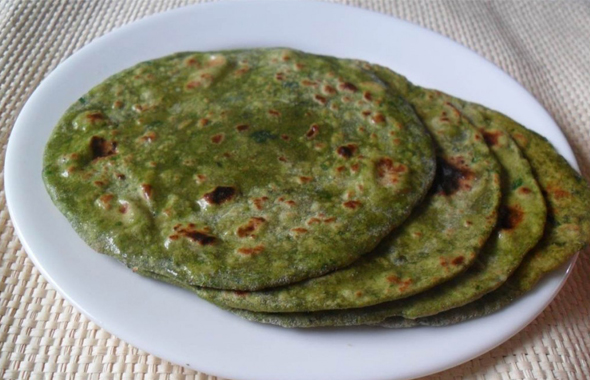Mama’s Punjabi Recipes – Methi ka Parantha(Fenugreek Parantha)
Punjabi paranthas have become famous all over the world not only because of their crispy, buttery whole wheat taste but also because they can be made stuffed with many varieties of vegetables and herbs. When my kids were little and we lived in London, for a special treat, I used to cook them paranthas stuffed with sugar or grated Cheddar cheese.
The most popular paranthas are filled with aloo (potatoes), gajjar (carrots), phul gobi (cauliflower), mouli (white radish) or piyaaz (onions). But, on occasion, I have made stuffed paranthas with left over daal (lentils). Paranthas can even be made with cooked ground meat, but they can’t really be eaten as a parantha then, it’s almost like a stuffed pizza. I have also made the frozen varieties that are available these days, but these do not have much stuffing which is why often you cannot taste the flavor.
There is a slight variation to the stuffed parantha, which is what this recipe is about. Instead of stuffing each ball of dough, you can add the flavor directly into the dough as you knead it. This method works just as well for methi as it does for the peelings of green kerelas (bitter gourds) and ajwain (bishop’s weed or carom seeds) paranthas; all of these are very beneficial for health. The same method can also be used when making namak-mirch (salt and pepper) paranthas which is a very quick and simple way to make them especially when you do not have any other ingredients around.
Punjabi paranthas can be eaten simply with plain yogurt or with achaar (pickles) especially aamb ka achaar (mango pickle). A true Punjabi would probably eat the parantha alone, just with a dollop of butter – preferably homemade white butter – that is placed on top of the hot parantha and melts into the top layer and you dab into the drippings. A glass of plain lassi (buttermilk) would top off the meal, which is heavy to digest and can also be heavy on calories.
Ingredients:
500 gm kanak (gehon) ka atta (wheat flour)
2 bunches of fresh methi (fenugreek)
2 tbsp tael (olive oil or vegetable oil)
½ cup plain dahi (yogurt)
1 1/2 cups pani (water)
Spices to taste: namak (salt), mirch (red pepper) der), garam masala, amchoor (mango powder)
Directions:
Wash the stems of methi and dry with a soft cloth. Remove the tougher stalks and then finely chop the methi. If fresh methi is not available, use dried methi, but first soak it for 10 minutes to let the dirt and hard stems separate and settle then skim the methi from the top. The more methi you use, the tastier the paranthas will be, but use at least one glass of methi for two glasses of flour.
Leave the dough in the refrigerator for 30 minutes. You should not cook the paranthas right after making the dough as they will come out hard. The oil and yogurt will help to make these paranthas soft.
Add two tablespoons of olive oil, salt and pepper to taste and all the methi to the dry flour and then proceed to knead it. Mix the yogurt with the water and then add it to the dough as you knead it. The dough should be soft but not watery.
Make dough into small paade (balls) and then roll out into an 8 to 10 inch circle.
Put a small dab of oil on a hot tava (hotplate or skillet) and place the flattened dough on. When it turns color a little, turn the pancake over. Put another dab of oil on the tava and then turn it over again till it is fully cooked. These paranthas will puff up and when they have some dark brown spots on them, it means they are cooked.
Because of the methi and yogurt, these paranthas are quite soft and easy for older people to eat. Try these with butter, yogurt or a plain daal for best taste.
 Shakuntla Malhotra is a skilled cook of Punjabi dishes made in the old-fashioned style that she learnt as a young woman in her ancestral home in Lyallpur, India before it became part of Pakistan after the Partition in 1947. People have often admired her cooking for its simplicity and taste that comes with each mouthful. Even in her mid-eighties, she continues to cook daily and agreed to share some of her delectable Punjabi recipes.
Shakuntla Malhotra is a skilled cook of Punjabi dishes made in the old-fashioned style that she learnt as a young woman in her ancestral home in Lyallpur, India before it became part of Pakistan after the Partition in 1947. People have often admired her cooking for its simplicity and taste that comes with each mouthful. Even in her mid-eighties, she continues to cook daily and agreed to share some of her delectable Punjabi recipes.

